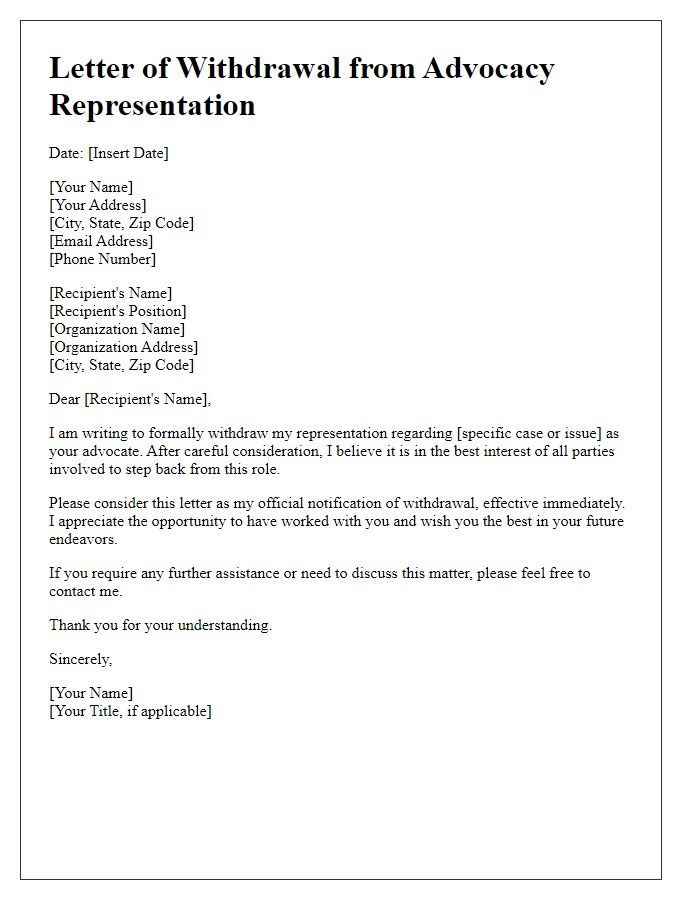Are you considering stepping back from a particular representation? It's important to communicate this decision clearly and respectfully, whether it's for personal or professional reasons. A well-crafted withdrawal letter can help maintain positive relationships while formally ending your representation. Let's dive into the essential elements of creating an effective withdrawal letter, and feel free to read more for tips and templates that will guide you through the process!

Client's name and contact information
Withdrawing from legal representation can have significant consequences for both the attorney and the client involved. A withdrawal letter should include essential details such as the client's full name, address, phone number, and email. Specific case information, including case number and court name, should be clearly stated. The attorney must cite the reasons for withdrawal, ensuring compliance with applicable state bar rules. Providing a deadline for the client to seek new representation, along with a list of important deadlines and upcoming court appearances, is crucial to ensure the client is informed. A professional and respectful tone, along with an acknowledgment of the client's future needs, will help maintain a positive relationship even after the termination of services.
Attorney's name and firm details
An attorney's withdrawal from representation typically involves formal communication outlining the details of the case and the attorney's intent. Elements such as the case name, court number, and client name are vital. Clear instructions on the next steps for the client should be provided to ensure a smooth transition. It is essential to include information about ongoing developments in the case and any deadlines that the client must be aware of. Additionally, the withdrawal notice should comply with local bar association rules and ensure that the client's rights are still protected.
Reason for withdrawal
Withdrawal from legal representation can occur for various reasons, such as conflicts of interest, non-payment of fees, or breakdown in communication. In the context of legal practice, a conflict of interest arises when the lawyer's ability to represent a client is compromised by other obligations to different clients. Non-payment of fees may involve an extended period, typically over 30 days, where the client fails to settle outstanding bills, prompting the attorney to reconsider ongoing representation. A breakdown in communication can manifest through a lack of response from the client, leading to difficulties in case development and strategy planning. Each of these reasons necessitates a formal process for withdrawal, ensuring adherence to professional conduct rules mandated by state bar associations.
Effective date of withdrawal
Withdrawal from legal representation can have significant implications for both the attorney and the client involved. Clients must be informed in a timely manner, ideally with a clear effective date, to allow for a smooth transition to new legal counsel. Attorneys should provide written notification of the withdrawal, ensuring it includes pertinent details such as case number, involved parties, and specific representation being terminated. This formal communication serves not only the legal requirement but also maintains professional integrity during the process. Having a clear effective date, typically agreed upon by both parties, allows clients adequate time to secure new representation without jeopardizing their legal standing or deadlines.
Instructions for future correspondence and pending matters
Withdrawal from legal representation requires clear communication with clients regarding future correspondence and pending matters. An attorney must detail the steps for clients to follow post-representation, including contact information for alternative legal assistance, deadlines for pending court appearances, such as those in county courts or federal courts, and instructions on accessing relevant case documents. Clients should be informed about the importance of maintaining communication regarding ongoing litigation, upcoming hearings, or settlement negotiations to avoid missing critical deadlines. Additionally, specifying the timeline for the transfer of documents or files is crucial for a seamless transition to new representation. Attorneys may also suggest local bar association resources for clients needing assistance with finding new attorneys or for questions related to their case.













Comments